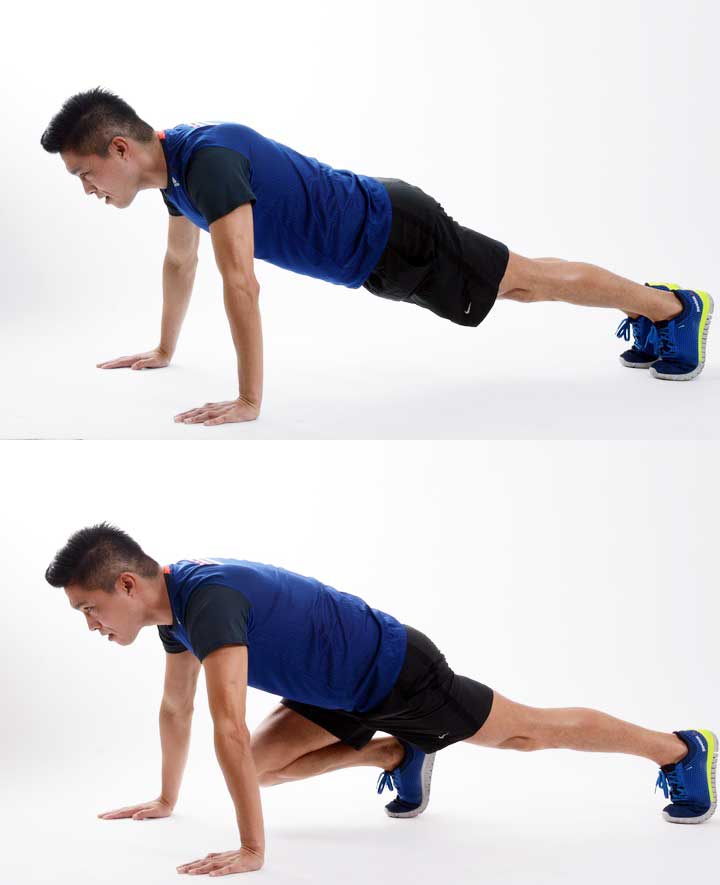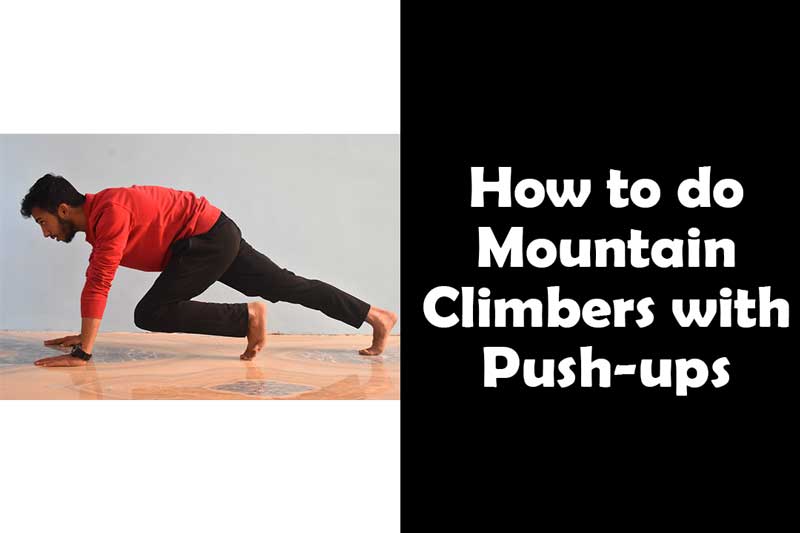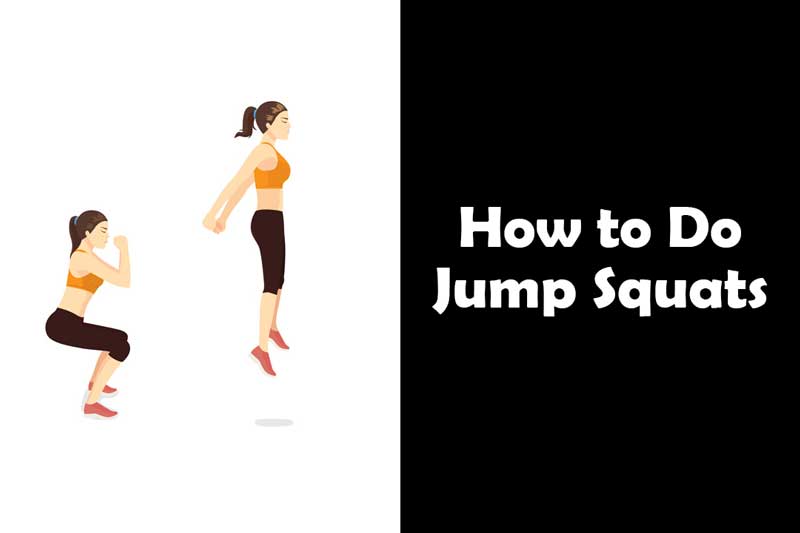Well, we all know about the push ups and how beneficial they are in bodybuilding. We also know about mountain climbers and its benefits for core strength and core muscles. But have you ever done mountain climbers with push-ups? It is one of the most amazing full body workouts.
This dynamic exercise combines the benefits of both mountain climbers and push-ups, delivering a full-body challenge that can help you build strength, endurance, and agility. In this article, we will delve into the details of this exercise, its benefits, how to perform it correctly, and why it should be a part of your fitness routine.
Benefits of Mountain Climbers with Push-ups
Strengthens the Upper Body
Mountain climbers with push-ups are an excellent compound exercise that engages various muscles in the upper body. As you perform the push-up component, your chest, shoulders, and triceps are targeted, promoting strength and muscle development in these areas.
Engages the Core Muscles
One of the significant benefits of this exercise is its ability to engage and strengthen the core muscles. The plank-like position maintained and movement of legs towards the chest during the mountain climber activates the abdominal muscles, obliques, and lower back, contributing to improved stability and overall core strength.
Targets the Lower Body
While primarily known for its upper body benefits, mountain climbers with push-ups also work the lower body. The leg movements involved in the mountain climber portion target the quadriceps, hamstrings, glutes, and calves, providing a well-rounded lower body workout.
Boosts Cardiovascular Fitness
The fast-paced nature of mountain climbers with push-ups elevates your heart rate, turning this exercise into an effective cardiovascular workout. Regularly incorporating this exercise into your routine can help improve your endurance and overall cardiovascular fitness.
Enhances Coordination and Agility
The combination of alternating leg movements in the mountain climber and the upper body push-up motion requires coordination and agility. By practicing this exercise, you can enhance your body’s ability to move fluidly and perform complex movements with ease.
Ho to do mountain climbers with push-ups (Proper Form and Technique)

To get the most out of your mountain climbers with push-ups, it’s crucial to maintain proper form and technique throughout the exercise. Follow these steps to perform it correctly:
Starting Position of Mountain Climbers with Push-ups
- Begin in a high plank position, with your hands slightly wider than shoulder-width apart and your body forming a straight line from head to heels.
- Engage your core muscles by drawing your navel toward your spine and squeezing your glutes.
Performing the Mountain Climber
- Drive your right knee toward your chest, keeping your foot off the ground.
- Quickly switch legs, bringing your left knee in while extending your right leg back.
- Continue alternating legs in a running motion, ensuring that your hips stay level and your back remains flat throughout the movement. You can do 4-10 reps each side (legs) before transitioning to push-ups.
Transitioning to the Push-up
- As soon as you have completed the desired number of mountain climbers according to your goals, stop and do the push ups.
- From the high plank position, bend your elbows and lower your chest toward the floor, maintaining a controlled and steady pace.
- Keep your elbows close to your body, and lower yourself until your chest is just above the ground.
- Push back up to the starting position, extending your arms fully.
Returning to the Mountain Climber
- After completing the push-up, return to the mountain climber position by driving your right knee toward your chest.
- Continue alternating between the mountain climber and push-up movements for the desired number of repetitions.
Remember to maintain a steady and controlled tempo throughout the exercise, focusing on engaging the target muscles while avoiding any jerky or uncontrolled movements.
Muscles Worked During Mountain Climbers with Push-ups
Mountain climbers with push-ups are a compound exercise that engages multiple muscle groups throughout the body. By understanding the specific muscles targeted, you can have a better understanding of the benefits and overall impact of this exercise on your physique. Let’s explore the key muscle groups worked during mountain climbers with push-ups:
Chest (Pectoralis Major and Minor)
The push-up component of mountain climbers with push-ups primarily targets the chest muscles. As you lower your body towards the ground and push back up, the pectoralis major and minor muscles are actively engaged, helping to build strength and definition in your chest.
Shoulders (Deltoids)
Both the anterior (front) and medial (side) heads of the deltoids are activated during mountain climbers with push-ups. These muscles assist in stabilizing the shoulders and play a crucial role in the pushing and pulling movements required for this exercise.
Triceps Brachii
Located at the back of the upper arm, the triceps brachii is a primary muscle involved in extending the elbow joint during the push-up phase of the exercise. Strong triceps contribute to overall upper body strength and definition.
Abdominals (Rectus Abdominis and Obliques)
The core muscles play a significant role in maintaining stability and proper form during mountain climbers with push-ups. The rectus abdominis, often referred to as the “six-pack” muscles, and the obliques are engaged to keep the body aligned and prevent excessive movement in the hips and lower back.
Lower Back (Erector Spinae)
The erector spinae muscles, which run along the spine, are involved in stabilizing the lower back during mountain climbers with push-ups. Keeping these muscles engaged helps maintain proper form and prevents excessive arching or rounding of the back.
Quadriceps
As you perform the mountain climber portion of the exercise, the quadriceps muscles located in the front of the thigh are activated. These muscles work to extend the knee joint as you drive your knees forward.
Hamstrings
The hamstrings, located at the back of the thigh, also play a role during the mountain climber phase. They assist in the movement of bringing the leg back to the starting position, working in coordination with the quadriceps.
Glutes
The gluteal muscles, including the gluteus maximus, medius, and minimus, are engaged during mountain climbers with push-ups to stabilize the hips and assist in leg movement. Strong glutes contribute to overall lower body strength and stability.
In addition to these primary muscle groups, mountain climbers with push-ups also activate other supporting muscles, including the calves, forearms, and muscles of the upper back.
Mountain Climbers with Push-ups Modifications and Progressions
Whether you’re a beginner or an experienced fitness enthusiast, the mountain climber with push-ups can be tailored to your fitness level. Here are some modifications and progressions you can consider:
Beginner Modifications of Mountain Climbers with Push-ups
- Perform the mountain climber portion by placing your hands on an elevated surface, such as a bench or step, to reduce the intensity.
- Or instead of a full push-up, you can start with modified push-ups on your knees until you build enough upper body strength.
Advanced Variations of Mountain Climbers with Push-ups
- Increase the speed and intensity of the mountain climber by driving your knees in and out quickly.
- Add a plyometric element to the exercise by explosively switching legs during the mountain climber phase.
- Elevate your feet on a stable platform, such as a bench, to increase the difficulty of the push-up component.
It’s important to choose modifications or progressions that challenge you without compromising your form or risking injury. Gradually progress as your strength and fitness levels improve.
You might also like other full body workouts:
Incorporating Mountain Climbers with Push-ups into Your Workout Routine
To reap the benefits of this eexercise, you can integrate them into your existing workout routine. Here are some guidelines to follow:
Warm-up for Mountain Climbers with Push-ups
Before starting the exercise, warm up your muscles and prepare your body for the workout. Perform a few minutes of light cardio, such as jogging or jumping jacks, followed by dynamic stretches to loosen up your joints and increase your range of motion.
Set and Repetition Guidelines
Here 1 rep is equal to the number of mountain climbers you do and end with the number of push-ups you have decided. Eg- 10 mountain climbers with each leg back to back (20 both legs), then 2-4 pushups – Equals 1 rep.
Beginners can start with one to 2 sets of 10 to 12 repetitions, gradually increasing the number of sets and repetitions as they get stronger. Advanced individuals can aim for three to four sets of 15 to 20 repetitions.
Combining Mountain Climbers with Push-ups with Other Exercises
For a comprehensive full-body workout, you can combine this exercise with other exercises such as squats, lunges, or planks. Alternate between different exercises to engage various muscle groups and keep your workouts dynamic.
Mountain Climbers with Push-ups Sample Workout Routine:
Here’s a sample workout routine that incorporates mountain climber with push-up:
1) Warm-up: 5-10 minutes of light cardio (e.g., jogging or jumping jacks) followed by dynamic stretches.
2) Exercise Circuit: Perform the following exercises in a circuit format, completing one set of each exercise before moving to the next. Rest for 30-60 seconds between sets and exercises and repeat the circuit for the desired number of rounds.
- Mountain Climbers with Push-ups: 3 Sets
- Squats: 3 sets of 12 repetitions
- Plank: Hold for 30 seconds (3 Sets)
- Bent-Over Rows: 3 sets of 12 repetitions
3) Superset: Perform the following exercises back-to-back without rest. Rest for 30-60 seconds between supersets and repeat for the desired number of sets.
- Mountain Climbers with Push-ups: 3 sets of 15 repetitions
- Walking Lunges: 3 sets of 12 repetitions (6 lunges per leg)
4) Core Finisher: Complete the workout with a core-focused exercise.
- Russian Twists: 3 sets of 15 repetitions (each side)
5) Cool-down: 5-10 minutes of light cardio (e.g., walking or jogging) followed by static stretches for major muscle groups.
Remember to adjust the intensity and volume of the workout to match your fitness level. It’s important to listen to your body and progress gradually over time. If you’re unsure about proper form or have any specific health concerns, consult with a qualified fitness professional before starting a new workout routine.
Common Mistakes to Avoid
To ensure you perform mountain climbers with push-ups correctly and maximize their effectiveness, avoid the following common mistakes:
Arching the Back
Maintain a neutral spine throughout the exercise and avoid excessive arching or rounding of the back. Engage your core muscles to keep your body stable and aligned.
Drooping Hips
Keep your hips in line with your body throughout the exercise. Avoid sagging or lifting your hips too high, as this can lead to improper form and reduced engagement of the target muscles.
Improper Hand Placement
Place your hands slightly wider than shoulder-width apart and align them with your chest. Avoid placing your hands too far forward or inward, as this can strain your wrists and compromise your form.
Rushing the Movement
Perform the exercise in a controlled and deliberate manner, focusing on proper form and muscle engagement. Avoid rushing through the movements, as this can lead to reduced effectiveness and increased risk of injury.
Safety Considerations for Mountain Climbers with Push-ups
While mountain climbers with push-ups are generally safe for most individuals, it’s important to keep the following safety considerations in mind:
Listen to Your Body
Pay attention to how your body feels during the exercise. If you experience pain, discomfort, or excessive fatigue, it’s essential to modify the exercise or seek guidance from a qualified fitness professional.
Gradual Progression
Progress gradually with this exercise, especially if you’re a beginner or returning to exercise after a break. Allow your body time to adapt and build strength progressively to minimize the risk of injury.
Warming Up and Cooling Down
Always warm up before performing mountain climbers with push-ups and cool down afterward. This helps prepare your muscles for the workout and aids in recovery, reducing the likelihood of muscle soreness or injury.
Conclusion
Mountain climbers with push-ups offer a challenging and effective workout that targets multiple muscle groups and improves cardiovascular fitness. By incorporating this exercise into your fitness routine, you can strengthen your upper body, engage your core, target your lower body, and enhance your overall coordination and agility. Remember to focus on proper form, listen to your body, and gradually progress according to your fitness level.
FAQs
1) Can anyone do mountain climbers with push-ups?
Mountain climbers with push-ups can be modified to suit different fitness levels. Beginners can start with easier modifications and progress gradually as their strength and endurance improve.
2) How many calories does this exercise burn?
The number of calories burned during mountain climbers with push-ups varies depending on factors such as your body weight, intensity, and duration of the exercise. On average, this exercise can burn approximately 8-12 calories per minute.
3) Can I do this exercise at home?
Yes, mountain climbers with push-ups can be performed at home with minimal equipment. All you need is a stable surface to support your hands during the exercise.
4) How often should I incorporate mountain climbers with push-ups into my routine?
The frequency of incorporating mountain climbers with push-ups into your routine depends on your overall fitness goals and the intensity of your workouts. Aim for at least two to three sessions per week, allowing adequate rest and recovery between sessions.
5) Can I replace regular push-ups with this exercise?
Mountain climber with push-ups provide a combination of upper body and core engagement, making them a great alternative or addition to regular push-ups. However, it’s always beneficial to include a variety of exercises in your routine to target different muscle groups.
And as always Say Yes to Strength!





